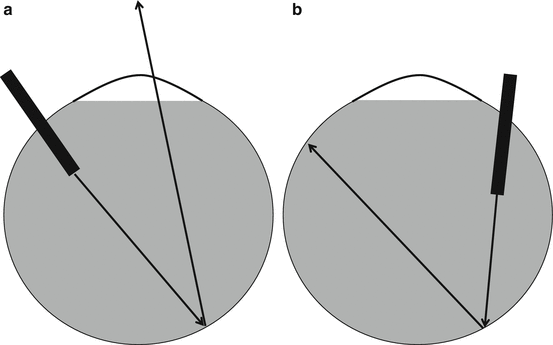(1)
St. Johns, FL, USA
(2)
Helen Keller Foundation for Research and Education, International Society of Ocular Trauma, Birmingham, AL, USA
(3)
Consultant and Vitreoretinal Surgeon, Milos Eye Hospital, Belgrade, Serbia
(4)
Consultant and Vitreoretinal Surgeon, Zagórskiego Eye Hospital, Cracow, Poland
22.1 The Light Pipe
Typically held in the surgeon’s nondominant hand, this light source is a very versatile one. The surgeon can influence the amount of light reaching the retina by changing the setting on the vitrectomy machine but also by changing the distance between the light pipe and the target area.1 The distance also influences the field of illumination. The surgeon can also change the angle of the light emission,2 enhancing the visibility of certain structures while “hiding” others. When using the BIOM, a wide-angle light pipe should be used.


Fig. 22.1
Light reflected in the air-filled eye. (a) If the light is shone across the eye, the angle of the reflected light is such that it blinds the surgeon. (b) If the light pipe is moved onto the same side of the eye where the illuminated area is, the reflected light does not directly reach the surgeon’s eye. This vastly improves his visibility
The light pipe can be employed in three basic ways.
During the operation the surgeon’s attention is focused on the actions executed by his dominant hand; moving and monitoring the position of the light pipe are rather automated.
The less experienced the surgeon, the closer he tends to hold the light pipe to the retina, dramatically increasing the risk of phototoxicity.5
It is not intuitive to keep the light pipe pulled back, close to the cannula. The light should be held as far away from the retina as consistent with still-adequate illumination. The surgeon must consciously monitor the light pipe’s position and hold it at a safe distance.
Q&A
Q
How can the surgeon ensure that he is keeping the light pipe far from the retina?
A




By constantly reminding himself to do it – and by asking his nurse to do the same.
Stay updated, free articles. Join our Telegram channel

Full access? Get Clinical Tree


